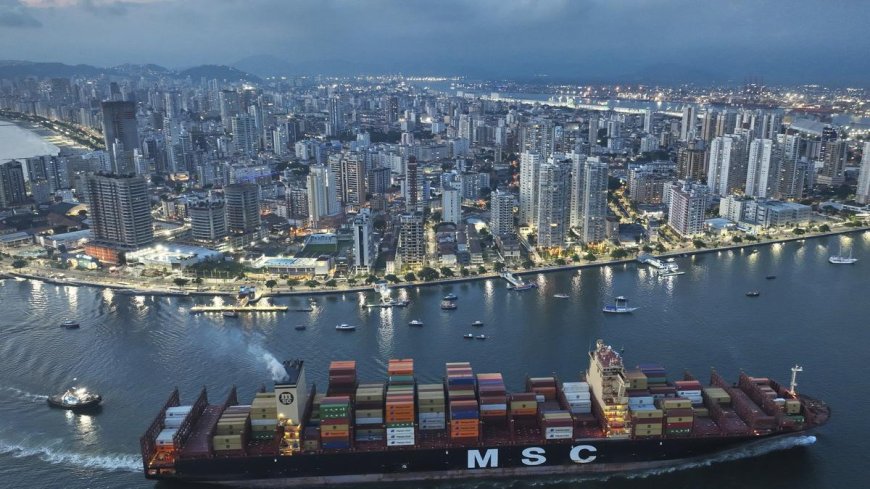How is the shipping industry tackling emissions? | Explained

How is the shipping industry tackling emissions? | Explained
Asarkari - Sarkari News, Jobs & Updates
By Priya Sharma
Kam sabdo me kahein to, the global shipping industry, a cornerstone of international trade, is navigating a complex transition towards decarbonization. Faced with mounting pressure to reduce its substantial environmental impact, the sector is actively exploring a diverse array of alternative fuels, innovative technologies, and stringent regulatory measures to chart a course towards a greener future.
The Rising Tide of Environmental Concern
The maritime shipping industry is the lifeblood of global commerce, responsible for transporting around 90% of world trade by volume. However, this vital role comes at a significant environmental cost. Ships predominantly rely on heavy fuel oil, a dense and polluting fossil fuel, making the sector a major contributor to global greenhouse gas (GHG) emissions, accounting for approximately 3% of the total. Beyond carbon dioxide (CO2), ships also emit sulphur oxides (SOx), nitrogen oxides (NOx), and particulate matter (PM), which have detrimental effects on air quality and human health, particularly in coastal communities and port cities.
The sheer scale of the challenge is immense. Without decisive action, emissions from shipping are projected to increase significantly as global trade continues to grow. This has spurred international bodies, national governments, and industry stakeholders to intensify efforts towards a sustainable maritime future.
Navigating the Regulatory Framework
The International Maritime Organization (IMO), the United Nations' specialized agency responsible for regulating shipping, is at the forefront of these efforts. A key milestone was the IMO 2020 regulation, which mandated a significant reduction in the sulphur content of fuel oil used by ships, from 3.5% to 0.5%. This has led to a widespread shift towards Very Low Sulphur Fuel Oil (VLSFO) or the installation of exhaust gas cleaning systems, commonly known as scrubbers.
More ambitiously, the IMO has laid out a comprehensive GHG strategy. The initial strategy, adopted in 2018, aimed to reduce total annual GHG emissions from international shipping by at least 50% by 2050 compared to 2008 levels, while also pursuing efforts towards phasing them out entirely. In 2023, these ambitions were significantly strengthened, with the revised strategy now targeting net-zero GHG emissions by or around 2050. Interim checkpoints include a 20% reduction (striving for 30%) by 2030 and a 70% reduction (striving for 80%) by 2040, compared to 2008 levels. Key technical and operational measures to achieve these goals include the Energy Efficiency Existing Ship Index (EEXI) and the Carbon Intensity Indicator (CII), which require ships to meet certain energy efficiency standards and progressively reduce their carbon intensity.
Regional initiatives, such as the European Union's "Fit for 55" package, which includes the extension of the EU Emissions Trading System (ETS) to maritime transport, are also exerting pressure on the industry to accelerate its decarbonization journey.
The Quest for Cleaner Fuels: A Diverse Portfolio
The transition away from conventional fossil fuels is central to shipping's decarbonization. A range of alternative fuels are being explored, each with its own set of advantages, challenges, and varying degrees of readiness:
Liquefied Natural Gas (LNG): Currently the most widely adopted alternative fuel, LNG offers immediate reductions in SOx, PM, and NOx emissions, and a modest reduction in CO2 (around 20-25%) compared to heavy fuel oil. However, concerns remain about methane slip – the leakage of unburned methane, a potent GHG – which can negate some of its climate benefits. Infrastructure for LNG bunkering is relatively more developed but still requires expansion.
Methanol: Methanol can be produced from natural gas (grey methanol) or, more sustainably, from renewable sources like biomass or captured carbon and green hydrogen (green methanol). Green methanol offers significant GHG reduction potential. It is liquid at ambient temperatures, making it easier to handle and store than LNG or ammonia. Several major shipping lines are investing in methanol-powered vessels.
Ammonia (NH3): Green ammonia, produced using renewable electricity and green hydrogen, is a zero-carbon fuel at the point of combustion. It is energy-dense and has an established global production and transport infrastructure, albeit primarily for fertilizers. However, ammonia is highly toxic, corrosive, and requires careful handling and new engine technologies. Its combustion can also lead to nitrous oxide (N2O) emissions if not properly managed.
Hydrogen (H2): Green hydrogen, produced via electrolysis powered by renewable energy, is another zero-carbon fuel. It can be used in fuel cells or internal combustion engines. The main challenges are its low volumetric energy density (requiring large storage tanks or frequent refueling) and the current high cost and limited availability of green hydrogen and its bunkering infrastructure.
Biofuels: Derived from biomass, biofuels like Hydrotreated Vegetable Oil (HVO) or Fatty Acid Methyl Esters (FAME) can be "drop-in" fuels, compatible with existing engines and infrastructure. Sustainable sourcing and scalability are key concerns to ensure they genuinely contribute to GHG reduction without causing deforestation or competing with food production.
Technological Innovations and Operational Measures
Alongside alternative fuels, technological advancements and operational efficiencies play a crucial role:
Energy Efficiency Technologies: These include optimized hull designs, air lubrication systems (which create a carpet of bubbles under the hull to reduce friction), wind-assisted propulsion (such as rotor sails and kites), advanced propeller designs, and waste heat recovery systems.
Operational Measures: Slow steaming (reducing vessel speed) can significantly cut fuel consumption and emissions. Weather routing, optimized port calls to reduce waiting times, and regular hull and propeller cleaning to minimize biofouling also contribute to improved efficiency.
Asarkari's Perspective: Charting a Just and Comprehensive Course
The maritime industry's journey towards decarbonization is not merely a technological challenge; it's a multifaceted transition with profound socio-economic implications. At Asarkari, we believe a holistic approach is paramount.
Firstly, the human element cannot be overlooked. The shift to new fuels and technologies necessitates comprehensive training and reskilling programs for seafarers and port workers. Ensuring a "just transition" means safeguarding livelihoods and creating new opportunities within the green maritime economy. For more updates on skill development and job opportunities, visit https://asarkari.com.
Secondly, India, with its extensive coastline, burgeoning economy, and renewable energy potential, has a unique opportunity to become a leader in this green transition. This extends beyond adopting greener shipping practices to potentially becoming a hub for green fuel production (like green hydrogen and ammonia) and innovative shipbuilding, aligning with national initiatives like "Make in India" and energy self-sufficiency. Investment in port infrastructure to support new fuels will be critical.
Thirdly, consistent and globally harmonized policies are the bedrock upon which industry investment will be built. The immense capital expenditure required for new vessels and infrastructure demands clear, long-term regulatory signals. Fragmented approaches or policy uncertainties can stall progress and create an uneven playing field.
Finally, it's crucial to recognize that this is a long-term endeavor. While interim targets for 2030 and 2040 are important milestones, the vision must extend towards continuous innovation and adaptation, fostering a culture of sustainability within the maritime sector for generations to come. The initial costs may be high, but the cost of inaction on climate change is immeasurably greater.
The Voyage Ahead: Challenges and Opportunities
The path to a zero-emission shipping industry is fraught with challenges. The cost of new fuels and technologies, the development of global bunkering infrastructure, ensuring the safety of new fuels, and achieving international consensus on regulations are significant hurdles. The "chicken and egg" dilemma – where shipowners hesitate to invest in new fuel-ready ships without fuel availability, and fuel producers await clear demand signals – also needs to be addressed through collaborative efforts and incentives.
Despite these challenges, the transition also presents immense opportunities for innovation, investment, and the creation of new green jobs. The drive for decarbonization is fostering collaboration across the maritime value chain, from fuel producers and technology developers to shipowners and ports.
Conclusion: Sailing Towards a Sustainable Horizon
The shipping industry is at a pivotal moment. The imperative to decarbonize is clear, and the journey, though complex, has begun. A combination of stringent regulations, technological innovation, investment in alternative fuels, and enhanced operational efficiencies will be essential. While the voyage will be long and require sustained commitment from all stakeholders, the destination – a sustainable, climate-neutral shipping industry – is vital for the health of our planet and the future of global trade. The collective will to innovate and collaborate will ultimately determine the speed and success of this green maritime revolution.
Team Asar
What's Your Reaction?
 Like
0
Like
0
 Dislike
0
Dislike
0
 Love
0
Love
0
 Funny
0
Funny
0
 Angry
0
Angry
0
 Sad
0
Sad
0
 Wow
0
Wow
0










































